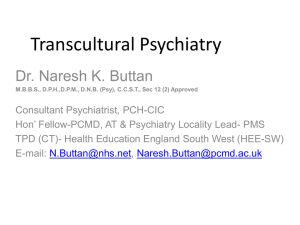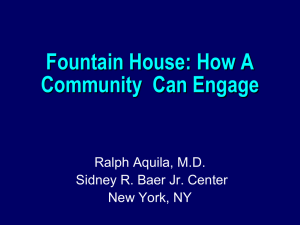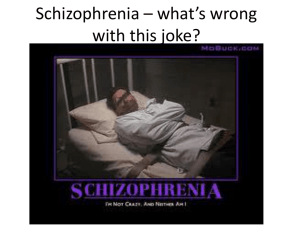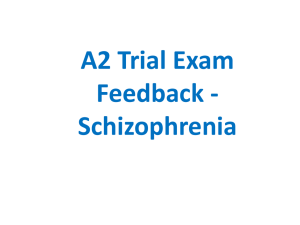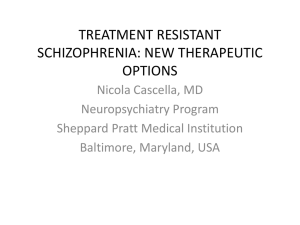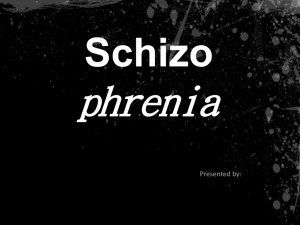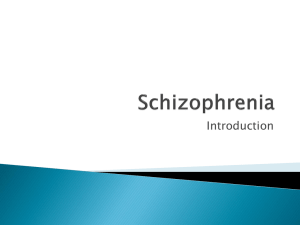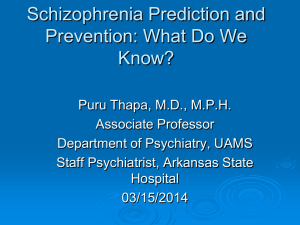Top Tips for GPs - Royal College of Psychiatrists
advertisement
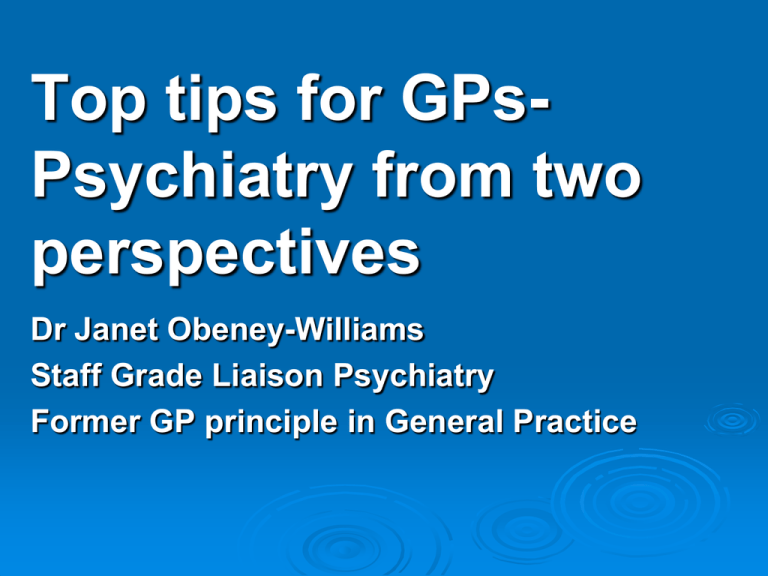
Top tips for GPsPsychiatry from two perspectives Dr Janet Obeney-Williams Staff Grade Liaison Psychiatry Former GP principle in General Practice What is general practice like? 'It is a world where the doctor is frequently in the dark, getting glimpses of his patients from time to time, being careful not to find out too much, being content to find out the right distance for the patient and for himself.’ -Dr Andrew Elder What is a psychiatrist? ‘Psychiatrists are medical doctors who must evaluate patients to determine whether or not their symptoms are the result of a physical illness, a combination of physical and mental, or a strictly psychiatric one.’ -Wikipedia 10,000 hours Psychologist Dr Nick Bayliss is famous for stating that it takes 10,000 hours to become an EXPERT-5 years of full time work Liaison Psychiatry Experts GP’s are experts We are experts at evaluating and treating in SHORT consultations over (sometimes) LONG periods of time We treat most problems without specialists Only 1 in 20 GP consultations results in a referral to specialists-Kings Fund 2010 No Health Without Mental Health (2011) Mental ill health represents up to 23% of the total burden of ill health in the UK-largest single cause of disability No health without mental health –HM Government 2011 Almost half of all adults will experience at least one episode of depression during their lifetime At least one in four people will experience a mental health problem at some point in their life and one in six adults has a mental health problem at any one time Self-harming in young people is not uncommon (10–13% of 15–16-year-olds have self-harmed) About one in 100 people has a severe mental health problem One in ten new mothers experiences postnatal depression Healthy Lives, Healthy People (2010) -White Paper First public health strategy that gives equal weight to both mental and physical health:. A preventive approach to mental health White Paper 2010 Britain is now the most obese nation in Europe By improving maternal health, we could give our children a better start in life, reduce infant mortality and the numbers of low birth-weight babies. White Paper 2010 In one study, the children of women who were depressed at 3 months after giving birth had significantly lower IQ scores at 11 years Taking better care of our children’s health and development could improve educational attainment and reduce the risks of mental illness, unhealthy lifestyles, Health and Social Care Act (2012) “Parity of esteem” between physical and mental health NHS Mandate 2012 to tackle disparities between physical and mental health care Topics Medically unexplained symptoms Schizophrenia and metabolic syndrome The ‘new psychoses’ Medically unexplained symptoms Medically unexplained symptoms are physical symptoms that lack a medically identifiable organic cause. Some studies suggest that one-fifth of initial appointments with GPs concern symptoms of this kind (Burton 2003). Medically unexplained symptoms in primary care Adult patients with medically unexplained symptoms (somatisation) in primary care are numerous and make disproportionately high demands on health services. Most of these individuals are open to the suggestion that their illness reflects psychological needs. (Else Guthrie-Advances in Psychiatric Treatment (2008) Expertise Irritable bowel syndrome Chronic pelvic pain Fibromyalgia Chronic fatigue syndrome Explanation Rejecting The doctor denies the reality of the patients’ symptoms and implies that the problem is imaginary or related to a psychological problem. Colluding The doctor acquiesces to the explanation offered by the patient Empowering The doctor provides a physical mechanism of causation The doctor removes any sense of blame from the patient The doctor strengthens the relationship with the patient, enabling them to resolve the problem together Source: Salmon et al (1999) Explanation GP’s we are experts in knowing this is unlikely to work! Colluding-we know this can undermine our patient’s confidence in our skills Empowering-we know this our best option Rejecting-as Empowering GP’s do this for our patients all the time We explore our patients Health Beliefs-a core competence in our Royal College examinations CSA We are Generalists so we can turn our hand to most explanations from the increased gastric acid in Dyspepsia or the reduced serotonin in Depression Exploring Another core competence for us-Cue’s, We have our own cohort of EXPERTS who’ve helped us become skilled at using our consultations to the best effect-Balint, Pendleton, Neighbour, the CambridgeCalgarry group and BATHE (relayed to us only this morning) Our Primary Care Inheritance Physical GP’s are used to explaining physical illness, in all systems of the body Our patients often appreciate the detail we give them Psychosocial As GP’s, when we’ve picked up our cues, hidden agenda’s we go on to address this with our patients-we’re probably Experts GP’s when surveyed have been shown to believe we should manage MOST MUPS GP’s are still Gatekeepers and, I would argue, EXPERTS When to refer? Appropriate and timely investigationssometimes essential to exclude organic causes When attendance is too frequent?? When someone develops an alarming symptom-we’ve all had that One Case who defied all the advice When we are stuck Evidence The children of parents who present with medically unexplained symptoms are at greater risk of developing such symptoms than are the offspring of parents with organic medical conditions (Levy et al, 2001; Craig et al, 2002). IBS-25% more visits Evidence Children with more aches and pains, tiredness and fatigue are more likely than their peers to develop anxiety and depression (Campo et al, 2004). Social learning theory is thought to be the most likely explanation Evidence A history of childhood adversity is common in patients with medically unexplained symptoms in primary care (Schilte et al, 2001). Depressive symptoms were the major predictor of frequent attendance in primary care populations in the UK and Spain (Dowrick et al, 2000). Evidence A group in the USA conducted an RCT of multidimensional stepped care consisting of cognitive–behavioural, pharmacological and other treatment modalities. During the 12-month trial, which involved 206 patients, 48 in the treatment group improved compared with 34 in the control group (Smith et al, 2006). Evidence Consensus of the evidence seems to be that if your patients will agree-CBT, treatment with anti-depressants (even if lack of a clear diagnosis of depression) can be helpful Refer for psychological therapies Factors associated with poor prognosis Somatic symptoms that have lasted for more than 2 years Childhood physical or sexual abuse History of psychiatric disorder Ongoing severe psychosocial stressors Psychiatry Patients who come to a liaison psychiatry clinic have already had ‘all’ their investigations Patients who’ve had Imaging, EEG’s, Telemetry, after spending time with many EXPERTS What can Psychiatry add? Some terms for MUPS Psychogenic Psychosomatic Non organic Unexplained Conversion medical symptoms Hysteria Somatoform disorders Functional Dissociative Psychiatry Sometimes management of Risk As a way into more complex psychological therapies Treatment of difficulty to manage comorbid mood disorders Patients see us as not being able to arrange investigations Non-epileptic seizures Between 1-15% of general neurology patients, up to 50% of patients referred to specialist epilepsy centres. Acute onset might be associated with a specific traumatic life event. Can present in people who also have epilepsy Non-epileptic seizures > in women, 75%:25% Usual onset in the 20s History of childhood sexual abuse in up to 50% Co-morbid epilepsy 15% Co-morbid personality disorder up to 40% (10% in epilepsy) Co-morbid anxiety and depression high in both groups Non-epileptic seizures Patients need neurological assessment with EEG and possible video-telemetry The nonexistence of epilepsy is best confirmed by the neurologist Non-epileptic seizures can result in overdose of benzodiazepines and patients can end up in ITU Can be easier to obtain negative results than some more non-specific illnesses such as fibromyalgia Non-epileptic seizures History and examination give indications of nonepileptic seizure Type of seizure – prolonged and frequent in the face of normal inter-ictal intellectual function Seizures in public places, especially clinics or hospitals Heightened distress after seizures e.g. prolonged crying Tongue biting, or or incontinence are less useful in distinguishing from epilepsy Schizophrenia Annual incidence in UK is 15-50 per 100,000 (same statistic as DVT on oral contraceptive in women) Strong evidence emerging for association of schizophrenia with complications during pregnancy and birth Increase in schizophrenia in late winter and spring births, thought to be associated with influenza virus contact in mid-trimester of pregnancy Schizophrenia & IQ Hutton and Joyce 1998, 2002 studies 136 people with schizophrenia and 81 controls showing cognitive impairment is there at First Episode and it is Generalised Pre-Morbid IQ tested by National Adult Reading Test Pre-Morbid IQ is linearly associated with presentation of Schizophrenia Lower the IQ the earlier the first age of presentation Relevance? Both Gray and White matter are affected in people with schizophrenia Leeson et al 2009 studied cognition at 1 and 4 years in relation to social outcome Only Global IQ :No other specific measure could predict global social function Can anything be done? 2005, Richard and Deary Boosting cognitive reserve in adulthood Educational attainment, community college Exercise Cardiorespiratory function Modern Imaging has shown us that the adult brain is more plastic than we originally thought, recruiting new neuronal pathways What does this add? Encouragement in outcome modification Some rigorous explanations which can be meaningful to patients and their families Under-pins other work such as importance of ante-natal nutrition All areas where GP’s are involved Schizophrenia and CHD All cause mortality in people with schizophrenia is >twice that in the general population CHD is a main player here and GP’s are expert at detecting and modifying this There is, however, evidence that even when BMI and other variables are controlled for, schizophrenia and insulin resistance are related Schizophrenia and CHD GP’s are Experts in lifestyle modification work GP’s are experts at Interventions To modify CHD and addressing the complexity of the metabolic syndrome and insulin resistance (psychiatrists are not) Schizophrenia and Diabetes Prevalence likely 15-18% Up to 1/3 may have impaired glucose tolerance High prevalence pre-dates the antipsychotic era GP’s are Experts at explaining risks to patients and working with motivation and concordance Schizophrenia and Diabetes The relationship between schizophrenia and diabetes is not fully understood. An association between the two conditions was recognised in the pre-antipsychotic era. Schizophrenia and diabetes may share a common aetiology and/or pathogenic mechanisms. Cochrane review 2010 Results indicate that regular exercise programmes are possible in this population, and that they can have health benefits on both the physical and mental health and well-being of individuals with schizophrenia. Larger randomised studies are required before any definitive conclusions can be reached The ‘new psychoses’ Potentially treatable psychoses which have been recognised in the last decade Can present with evident confusion and neurological symptoms, making diagnosis challenging Some patients present with predominantly psychiatric symptoms and have been diagnosed with schizophrenia The ‘new psychoses’ anti-NMDA receptor encephalitis can have additional features of dyskinesias, seizures and catatonia Can be associated with ovarian pathology diagnosis requires a positive finding of antibodies to the NMDA receptor The ‘new psychoses’ There are distinct prodromal, psychotic, unresponsive, hyperkinetic and recovery phases Recovery is not always to the pre-morbid level High mortality rate (25% in a case study of 100) Diagnosis is made by detecting the antibodies in serum-Oxford The ‘new psychoses’ Treatment is immunomodulatory agents, including plasmapheresis or high-dose steroids Anti-psychotics and benzodiazepines have a supportive role in treatment unclear whether there is a pure psychiatric presentation associated with lower antibody titres. NMDA N-methyl-D-aspartate receptor (also known as the NMDA receptor a glutamate receptor, is the predominant molecular device for controlling synaptic plasticity and memory function Hypo-function of Glutamate is emerging as a likely cause of schizophrenia, alongside the Dopamine hypothesis In Summary Potentially treatable psychosis Role of investigations pivotal to diagnosis Ongoing research in this areaepidemiological and investigative To summarise Mental illness is beginning to be recognised as the huge public health concern that we ‘experts’ know only too well that it is Some of the well known causes of poor health-nutrition, Obesity, metabolic syndrome and the range of unformulated symptoms which present in primary care To summarise GP’s are managing majority of mental illness without involving specialists Evidence supports the impact of the holistic care in the areas we’ve looked at When to or why refer? The public health challenges Some new science Thanks
